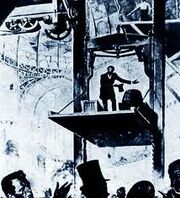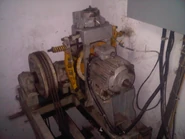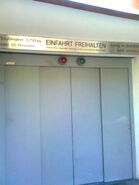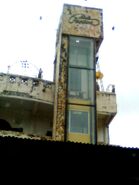
|
"This elevator needs to be fixed!" The content of this page or section needs to be rewritten. Please help the Elevatorpedia by expanding it. |

|
Elevator (or lift) is a vertical transport vehicle that efficiently moves people or goods between floors of a building. They are generally powered by electric motors that either drive traction cables and counterweight systems, or pump hydraulic fluid to raise a cylindrical piston.
History
Primitive elevators dates back to ancient Rome, where Archimedes designed one supported by hemp ropes and powered by animals. By the 1800s the technology had not greatly improved and the lifts that existed were notoriously dangerous. Due to the high risk, these lifts were reserved almost solely for moving objects, not people.
Medieval records contain numerous drawings of hoists lifting men and supplies to isolated locations. Among the most famous is the hoist at the monastery of St. Barlaam in Greece. The monastery stood on a pinnacle approximately 61 meters (200 ft) above the ground. Its hoist, which employed a basket or cargo net, was the only means up or down. At an abbey on the French seacoast, a hoist was installed in 1203 that used a large tread wheel. A donkey supplied the lifting power. The load was raised by a rope wound on a large drum. Manpower supplied the lifting force in many early devices. By the 18th century, machine power was being applied to the development of the elevator.
In 1743, a counterweighted personal elevator was commissioned by Louis XV in France for his personal chambers in Versailles. By 1833, a system using reciprocating rods raised and lowered miners in Germany’s Harz Mountains. A belt-driven elevator called the “teagle” was installed in an English factory in 1835. The first hydraulic industrial elevator powered by water pressure appeared in 1846. As machinery and engineering improved, other powered lifting devices quickly followed.
First elevator invention by Otis

Otis demonstrates his safety elevator at the 1953 World's Fair.
On 1953, an inventor named Elisha Otis had designed a safety system that would catch a falling lift should its main support fail. He proudly demonstrated this breakthrough at the 1853 World’s Fair in New York’s Crystal Palace. Otis stood on the elevated platform high above the crowd then directed a burly assistant to sever the support cable with an axe. The platform dropped a few inches but the safety system quickly stopped the descent.
A few years later when a state-of-the-art building was constructed to house the E.V. Haughwout chinaware emporium, the architects decided to include the very first Otis passenger elevator at a cost of $300. That same elevator is still in working condition.
The first successful passenger elevator was installed on this day at 488 Broadway in New York City on March 23, 1857.
In 1880, Werner von Siemens invented the first electric elevator.
Elevator powers
Traction
cars are pulled up by means of rolling steel ropes over a deeply grooved pulley, commonly called a sheave in the industry. The weight of the car is balanced by a counterweight. Sometimes two elevators are built so that their cars always move synchronously in opposite directions, and are each other's counterweight.
Geared traction
As the name implies, the electric motor in this design drives a wormand-gear-type reduction unit, which turns the hoisting sheave. While the lift rates are slower than in a typical gearless elevator, the gear reduction offers the advantage of requiring a less powerful motor to turn the sheave. These elevators typically operate at speeds from 38 to 152 meters (125-500 ft) per minute and carry loads of up to 13,600 kilograms (30,000 lb). An electrically controlled brake between the motor and the reduction unit stops the elevator, holding the car at the desired floor level.
Gearless traction
In a gearless traction machine, six to eight lengths of wire cable, known as hoisting ropes, are attached to the top of the elevator and wrapped around the drive sheave in special grooves. The other ends of the cables are attached to a counterweight that moves up and down in the hoistway on its own guiderails. The combined weight of the elevator car and the counterweight presses the cables into the grooves on the drive sheave, providing the necessary traction as the sheave turns.
To reduce the load on the motor, the counterweight is calculated to match the weight of the car and a half-load of passengers. As the car rises, the counterweight descends, balancing the load. This reduces energy consumption because the motor is required to lift no more than the weight of half a car load at any time. The grooved sheave in this traditional gearless system is quite large, from 0.6 to 1.2 meters (2–4 ft) in diameter. The electric motor that runs it must be powerful enough to turn this large drive sheave at 50–200 revolutions per minute in order to move the elevator at the proper rate.
Safety is provided by a governing device that engages the car’s brakes, should the elevator begin to fall. A powerful clamp clutches the steel governor cable, which activates two safety clamps located beneath the car. Moveable steel jaws wedge themselves against the guiderails until sufficient force is exerted to bring the car to a smooth stop.
Hydraulic
Hydraulic elevators are used extensively in buildings up to five or six stories high. These elevators—which can operate at speeds up to 46 meters (150 ft) per minute—do not use the large overhead hoisting machinery the way geared and gearless systems do. Instead, a typical hydraulic elevator is powered by a piston that travels inside a cylinder. An electric motor pumps oil into the cylinder to move the piston. The piston smoothly lifts the elevator cab. Electrical valves control the release of the oil for a gentle descent.
Holed hydraulic
With holed hydraulic systems, the elevator car is mounted on a piston that travels inside a cylinder. The cylinder extends into the ground to a depth equal to the height the elevator will rise. As hydraulic fluid is pumped into the cylinder through a valve, the car rises. As the fluid returns to the reservoir, the car descends.
Holeless hydraulic
Holeless hydraulic consists of pistons mounted inside the hoistway to raise and lower the car. This is especially a solution for buildings built in bedrock, a high water table or unstable soil conditions locations that can make digging the hole required for a conventional hydraulic elevator impractical.
Roped hydraulic
Roped hydraulic elevator extends the rise of the holeless elevator to 18 meters (60 ft), without the need for a belowground cylinder.
Machine Room Less (M.R.L.)
Main article: Machine Room Less Elevator
Elevator control
Automatic control
As passengers step on and off an elevator, the load constantly changes, making it difficult to keep the platform level with the floor. Otis solved this problem as far back as 1915 with a self-leveling device called Microdrive. First developed for lifts in naval vessels, Otis introduced it as a safety device in passenger elevators. It also saved time and improved the ride quality for passengers as the leveling operation was automatic.
Older elevators before 1980s uses mechanical selectors that uses analog controls and many moving parts to determine the car’s position, requiring constant and often costly maintenance.
Breakthroughs in computer technology continue to enhance the quality and reliability of modern elevators. Beginning in 1979 with Otis’ Elevonic®101 system, the power of microprocessors has been increasingly employed to control every aspect of elevator operation.
Judging when to slow the cab was easy enough for an operator when speeds were between 91–121 meters (300–400 ft) per minute. But when speeds increased to over 213 meters (700 ft) per minute, this became too difficult. The logical step was to automate the control system.
In 1924, Otis installed its first Signal Control System in the new Standard Oil Building in New York City. The system automatically controlled acceleration, speed between floors and deceleration as the car approached the landing. In 1937, the Peak Period Control was introduced to automatically schedule elevator service during high-demand periods. It helped reduce the waiting time on any given floor by coordinating the movement of the building’s elevators.
Electric door safeguards and more sophisticated dispatching systems followed, allowing elevators to become fully automatic.
Elevator algorithm
Main article: Elevator algorithm
Types of elevators
Passenger elevator
A passenger elevator is designed to move people between a building's floors. Passenger elevators capacity is related to the available floor space. Generally passenger elevators are available in capacities from 1,000 to 6,000 pounds (450–2,700 kg) in 500 lb (230 kg) increments. Generally passenger elevators in buildings eight floors or less are hydraulic or electric, which can reach speeds up to 200 ft/min (1.0 m/s) hydraulic and up to 500 ft/min electric. In buildings up to ten floors, electric and gearless elevators are likely to have speeds up to 500 ft/min (2.5 m/s), and above ten floors speeds begin at 500 ft/min (2.5 m/s) up to 2000 ft/min (10 m/s).
Bed elevator
A bed elevator is a deeper version of passenger elevators, and can be used to carry beds or stretchers. In hospitals that have separate bed and passenger elevators, the bed elevator is usually reserved for patients only. Most bed elevators' speed are slightly slower than passenger elevators' speed, to make the patient feel comfortable when riding in the elevator.
Service elevator
A service elevator is normally used by building staffs instead of other people. Sometimes, these elevators maybe used to carry goods instead of passengers. Most service elevators' speed are more slower than passenger elevators' speed.
The service elevators' dimensions can be the same or larger than passenger elevators, deep like bed elevators, but most service elevators do not as large as freight elevators.
Freight elevator
A freight elevator, or goods lift, is an elevator designed to carry goods, rather than passengers. Freight elevators are generally required to display a written notice in the car that the use by passengers is prohibited (though not necessarily illegal), though certain freight elevators allow dual use through the use of an inconspicuous riser. Freight elevators are typically larger and capable of carrying heavier loads than a passenger elevator, generally from 2,300 to 4,500 kg. Freight elevators may have manually operated doors, and often have rugged interior finishes to prevent damage while loading and unloading. Although hydraulic freight elevators exist, electric elevators are more energy efficient for the work of freight lifting.
These elevators are specially constructed to withstand the rigors of heavy loads. Standard capacities range from 1360 kilograms (3000 lb) up to 5440 kilograms (12,000 lb). These elevators are rated according to load categories, with Class “A” being for hand trucks, Class “B” for carrying automobiles and Class “C1” for elevators with the capacity to carry a commercial truck.
Dumbwaiter
A dumbwaiter is used to carry smaller goods. Unlike freight elevators, dumbwaiters' doors are offsetted from the floor, and passengers can't ride the dumbwaiter at all because it is smaller than freight elevators.
Vehicle elevator
Vehicular elevators (or car lift) are used within buildings or areas with limited space (in lieu of ramps), typically to move cars into the parking garage or manufacturer's storage. Geared hydraulic chains (not unlike bicycle chains) generate lift for the platform and there are no counterweights. To accommodate building designs and improve accessibility, the platform may rotate so that the driver only has to drive forward. Most vehicle elevators have a weight capacity of 2 tons.
Double Deck elevator
Main article: Double Deck Elevator
Double-deck elevators save time and space in high-occupancy buildings by mounting one car upon another. One car stops at even floors and the other stops at the odd floors. Depending on their destination, passengers can mount one car in the lobby or take an escalator to a landing for the alternate car.
Observation elevator
The observation elevator puts the cab on the outside of the building. Glass-walled elevator cars allow passengers to view the cityscape or the building’s atrium as they travel. By eliminating the hoistways, the observation elevator also offers owners, architects and builders valuable space-saving advantages.
Residential/home elevator
The residential elevator is often permitted to be of lower cost and complexity than full commercial elevators. They may have unique design characteristics suited for home furnishings, such as hinged wooden shaft-access doors rather than the typical metal sliding doors of commercial elevators. Construction may be less robust than in commercial designs with shorter maintenance periods, but safety systems such as locks on shaft access doors, fall arrestors, and emergency phones must still be present in the event of malfunction.
Elevator special modes
- Anti-Crime Protection (ACP)
- Emergency power operation (EPR)
- Fire service mode (EFS)
- Independent service (ISC)
- Inspection service (INS)
- Medical emergency/Code Blue service (EHS)
- Sabbath service (SHO)


